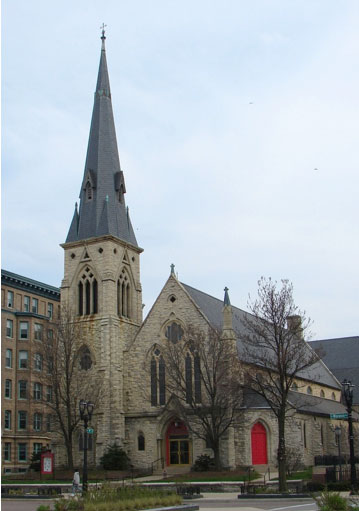25. St. James Episcopal, 1867
833 West Wisconsin Avenue
Architect: Gordon Lloyd (Detroit)
St. Paul’s Episcopal Church, in the Yankee Hill neighborhood on the city’s East Side, established a mission church on the west side of the Milwaukee River in 1846. The mission incorporated as Trinity Church the following year, as the city’s second Episcopal parish. However, the parish lasted only a few years, becoming dormant by 1849. Recognizing the need for an Episcopal church on the city’s growing West Side, St. Paul’s established a new daughter church, St. James, in 1850. St. James purchased a small Greek Revival style church at Grand Avenue (now Wisconsin Avenue) and 2nd Street from a disbanded Unitarian congregation, and moved the building seven blocks to the site of the present church. Dating to the period of Milwaukee’s early settlement, the building was rather primitive, with two stoves in the nave providing heat during the winter months and no lighting. In spite of the austere conditions, the building served the parish until construction of the present church just after the Civil War.
To design its new church, St. James Parish turned to Detroit architect Gordon Lloyd (1832-1904). Lloyd was born in England and immigrated to Canada with his family as a child. He returned to England in 1847, where he apprenticed in the London office of his uncle, Ewan Christian, a prolific designer of Gothic Revival churches. Returning to North America after several years of training in England, Lloyd established an office in Detroit in 1858 (although he maintained a residence across the Detroit River in Windsor, Ontario). A favored architect of the Episcopal Church, Lloyd designed at least six churches for this denomination in Michigan. He also designed Episcopal churches in Illinois, Ohio, and Pennsylvania, in addition to St. James in Milwaukee.
In addition to being the city’s oldest Gothic Revival church, St. James is believed to be the first stone church erected in Milwaukee. It is the oldest surviving church of any style with walls built entirely of stone. The limestone for the exterior was quarried in Wauwatosa in western Milwaukee County.
The church was built on the site of one of the city’s earliest cemeteries. Prior to construction, the graves and markers were removed to Forest Home Cemetery on the South Side, at that time just outside the city limits. Construction of the church began in 1867 and the first services in the new building were held the following summer. Completion of the tower and steeple were delayed until 1871 due to a shortage of funds. The plans also called for a deep chancel at the south end of the church that was not built originally.
Tragedy struck only a few years after completion of the church, when a fire of unknown origin consumed most of the building on New Year’s Eve in 1872. The fire destroyed the interior of the church, leaving intact only the perimeter walls, the tower and steeple, and some of the windows. The parish had the church rebuilt in accordance with the original plans by Gordon Lloyd, with the first service in April of 1874. The deep chancel that was part of Lloyd’s original design was included in the reconstruction project, making the completed church 28 feet longer than it had been prior to the fire.
St. James Episcopal has a basilican plan with very short clerestory windows in the nave. The church possesses a variety of stained glass windows, installed from the 1870s to the 1950s. Among these are two Tiffany windows.
Sources:
100 Years of Faith and Service, 1850-1950. St. James Episcopal Church, 1950.
Cullom, Marla O., Barbara E. Krueger, and Dorothy Kostuch. Detroit’s Historic Places of Worship. Wayne State University Press, 2012.
Eckert, Kathryn Bishop. Buildings of Michigan. Oxford University Press, 1993.
“Episcopal,” Milwaukee Sentinel, April 18, 1874, page 8, column 1.
Flower, Frank A. History of Milwaukee, Wisconsin. Western Historical Company, 1881. Facsimile reprint by the Milwaukee Genealogical Society, 1981.
“Gordon W. Lloyd” (obituary), Detroit Free Press, December 25, 1904, part 1, page 5, column 3.
Historical Sketch of St. James’ Church, Milwaukee, Wisconsin, 1850-1907. St. James Episcopal Church, 1907.
Hundt, Katherine E. National Register of Historic Places nomination, St. James Episcopal Church, 1978.
“The Parish of St. James,” Milwaukee Sentinel, January 16, 1873, page 4, column 2.
“St. James Church,” Milwaukee Sentinel, July 26, 1867, page 1, column 3.
“St. James Church,” Milwaukee Sentinel, January 22, 1873, page 4, column 1.
“St. James Church,” Milwaukee Sentinel, July 20, 1873, page 8, column 5.
St. James Church: Seventy-fifth Anniversary. St. James Episcopal Church, 1925.
Wietczykowski, Mary Ellen. St. James’ Episcopal Church. Historic American Buildings Survey, 1969. HABS No. WI-255.



